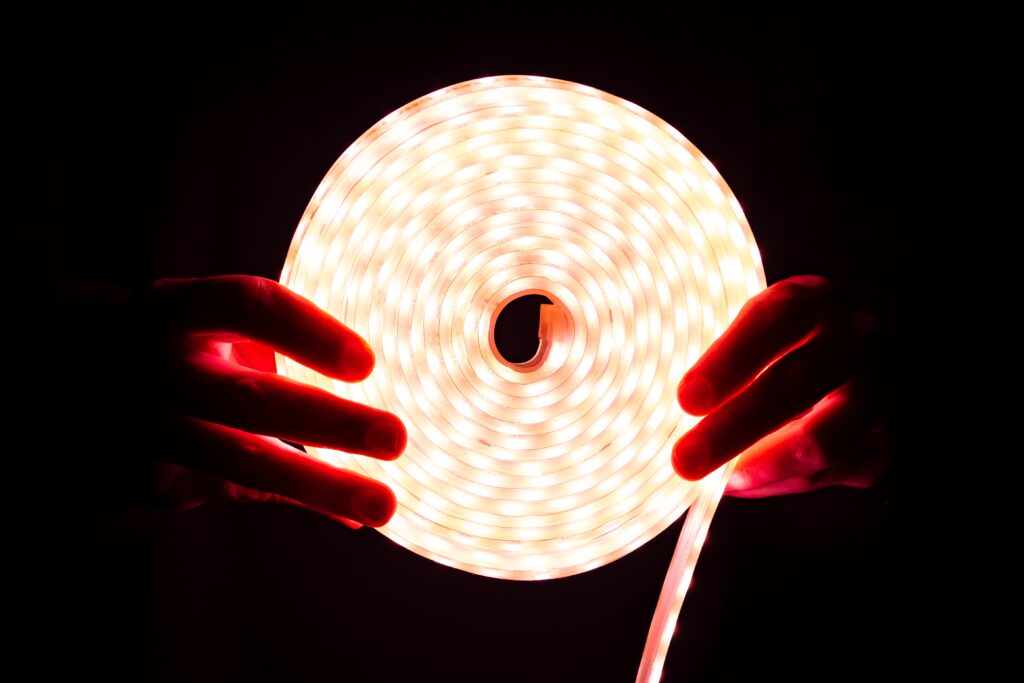LED strip lights are an increasingly popular lighting solution, known for their flexiblity, versatility, energy efficiency, and vibrant illumination. Whether used for home decor, commercial spaces, or architectural lighting, LED strips can offer many advantages.
However, one of the most frequently asked questions is: How long do LED strip lights last? Let’s explore the factors that determine the lifetime of LED strip lights and how to get the most out of them from this article!

Understanding LED Lifespan
The lifespan of LED strip lights is often quoted as 25,000 to 50,000 hours. This range can vary depending on the quality of the strip, the brand, and the conditions in which they are used. To put this in perspective:
- 25,000 hours is about 2.8 years if the lights are on 24 hours a day.
- 50,000 hours translates to over 5.7 years of continuous use.
However, most users don’t operate their LED strip lights continuously. Assuming typical use of 8 hours averagely per day, a high-quality LED strip could last upwards of 17 years.
Factors Affecting the Lifetime of LED Strip Lights
While LED strips are built to last, their actual lifespan depends on several factors:
1. Quality of Components
Not all LED strip lights are created equal. The quality of the LED chips, resistors, and PCBs directly influences their durability. High-quality materials ensure better heat dissipation, more stable electrical performance, and ultimately a longer lifespan. Cheaper strips, on the other hand, might not last as long due to inferior components.
2. Heat Management
LEDs generate heat, and without proper heat dissipation, their lifespan can be reduced. High temperatures can cause the LED chip to degrade over time, resulting in reduced brightness or failure. Many high-quality LED strips come with built-in heat sinks or use external aluminum profiles that help with cooling, extending their lifespan.
3. Power Supply
Using the correct power supply is crucial for the longevity of LED strip lights. Overloading the strip with more voltage than it can handle will cause burnout, while underpowering it may result in flickering and reduced brightness. Always check the voltage and current requirements and use an appropriate power adapter to prevent damage.
4. Installation Environment
Where and how you install LED strip lights also affects their lifetime. Strips placed in harsh environments, such as areas with high humidity, dust, or direct sunlight, may deteriorate faster. For outdoor or damp locations, it’s essential to use LED strips with an IP rating that indicates they are waterproof or dustproof.
5. Dimming and Usage Patterns
Constantly operating LED strip lights at maximum brightness can shorten their lifespan. Using dimmers can reduce the strain on the diodes, helping them last longer. Additionally, frequent on/off cycles don’t impact LED lights as much as traditional lighting, but it’s still a good practice to avoid unnecessary use.
Signs That Your LED Strip Lights Are Reaching the End of Their Lifespan
LEDs don’t suddenly stop working like incandescent or fluorescent bulbs. Instead, they gradually dim over time. When your LED strip lights have reached about 70% of their original brightness, they are considered to have reached the end of their “useful” lifespan. Other signs include:
- Flickering or inconsistent brightness
- Discoloration of the LEDs
- Burnt or discolored sections of the strip
How to Maximize the Lifespan of Your LED Strip Lights
To ensure your LED strip lights last as long as possible, follow these best practices:
- Choose high-quality products: Invest in LED strips from reputable manufacturers with good warranties and reviews.
- Ensure proper ventilation: Avoid installing LED strips in confined spaces where heat can build up, or use heat sinks for better cooling.
- Use the right power supply: Ensure the voltage and current match the requirements of the LED strip.
- Opt for dimmers: Dimming LED strip lights reduces stress on the diodes, extending their life.
- Check the IP rating: For outdoor or moisture-prone areas, select LED strips with appropriate protection.
Conclusion
LED strip lights are designed to offer a long service life, with proper care and installation extending their lifespan to its maximum potential. By considering factors such as quality, heat management, and correct power usage, you can enjoy years of beautiful lighting from your LED strips. With their energy efficiency and durability, LED strip lights are a smart investment for both residential and commercial lighting needs.
Whether you’re looking for ambient lighting or creative decor solutions, understanding the lifetime of LED strip lights ensures you get the best value for your money.
Talk with Shine Lighting team to get the best LED strip light solution now!


